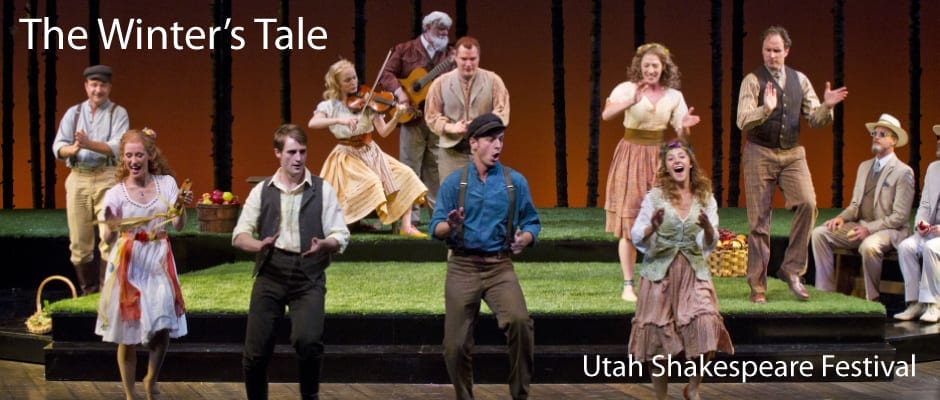
Jonathan Gillard Daly as Antigonus in the Utah Shakespeare Festival’s 2011 production of The Winter’s Tale. (Photo by Karl Hugh. Copyright Utah Shakespeare Festival 2011).
CEDAR CITY — Shakespeare is well-known for his work in the three main genres that his plays fit into: histories, comedies, and tragedies. However, many of his later plays fall into the category of romances, with The Tempest being the best known play in this group. The romances have been a largely misunderstood genre for a variety of reasons. First, with the exception of The Tempest, none of these scripts (Pericles, Cymbeline, and The Winter’s Tale, though sometimes Two Noble Kinsmen is included in the group) are among the Bard’s most frequently produced and most beloved works. Second, the word “romance” today has been co-opted by romance novels and romantic comedy movies to mean strictly a love story. However, the medieval and Renaissance romance was a fantastical tale of high adventure, supernatural events, and exotic locations. At the time of the genre’s development during the high middle ages, romanz was a word that referred to the vernacular language spoken in modern-day France and was applied to fictional tales written in that language to distinguish them from literature written in Latin. As romances spread to other languages, the word came to apply to the genre of these stories, rather than the language they were written in. Arthurian legends (like the quest for the Holy Grail), some of the stories from the Canterbury Tales, and Orlando Furioso are the best known stories of the romance genre.
Shakespeare’s A Winter Tale fits perfectly in the romance genre. In this story, Polixenes, the King of Bohemia, is visiting his lifelong friend Leontes, the King of Sicilia. After a lengthy stay with his friend, Polixenes leaves to return to his kingdom, but Leontes begs him to stay. When he is unsuccessful, Leontes gets his wife Hermione to ask Polixenes to extend his visit. Hermione is able to easily convince Polixenes to stay, which makes Leontes suspicious of his wife and her relationship with his friend. Suspecting infidelity and believing that the child that Hermione carries was fathered by Polixenes, Leontes banishes his wife, whom he believes dies soon after giving birth. The baby, a daughter named Perdita, is ordered killed, but the nobleman (Antigonus) ordered to execute the child takes pity on her and instead abandons her in a Bohemian forest. The rest of the play takes place sixteen years later when Perdita is grown up, having been adopted by a rustic shepherd. Polixenes’s son Florizel attends a sheep sheering festival in disguise and decides to marry Perdita. Polixenes is against the marriage and the lovers flee to Sicilia where a miraculous turn of events resolves all conflicts in a satisfactory manner.
Unlike Shakespeare’s other stories involving kings and international relations, the drama of A Winter’s Tale is not concerned with battles and the fate of kingdoms, but rather with family relations between parents and children, husbands and wives, and friends. I feel that most of the plot elements would be unaffected if transposed to a different social class. However, instead of making the plot more accessible to a modern audience, I believe that there are aspects of A Winter’s Tale that will prevent it from gaining the widespread acceptance that Shakespeare’s most famous works have obtained. For example, Leontes acts extraordinarily irrational in the first half of the play, going even so far as to convict his wife of adultery in a trial, even when all the evidence is in her favor. I couldn’t discern a reason for Leontes’s irrationality, which made it more difficult for me to have sympathy for him when the playwright expects it in the second half.
Another odd characteristic of A Winter’s Tale is the mismatch between the two halves of the play. The first half is a joyless, dour affair, as the conflict is established and Leontes gradually destroys almost every relationship he had at the beginning of the play. Shortly after the action moves to Bohemia, however, the mood of the play shifts abruptly and becomes a charming rustic comedic drama. To me the first half felt like Hamlet and the last half felt like Much Ado About Nothing. To have such drastically different moods in the same script could be grounds for criticism of Shakespeare for a lack of dramatic unity.
Rather than ignore the vastly different natures of the two halves of the play, director Laura Gordon emphasized Shakespeare’s (flawed?) dramatic structure. She employed every tool she had at her disposal to give a tragic mood to the action in Sicilia. I believe that this was the prime motivation behind Gordon’s decision to place the action at the turn of the 20th century. The emphasis of the formal, constrained life of the Sicilian court was clear as characters (such as Leontes, Hermione, and Camillo) obeyed the strict laws of decorum and behavior that were imposed on upper class society that existed a century ago.
But the greatest contributions to the depressing, tragic mood of the first half of the play were the set (designed by Jo Winiarski) and the lighting (designed by Donna Ruzika). The set consisted mostly of a series of panels that stretched to the top of the proscenium that were semi-translucent when lit from behind. These panels were classy and coincided nicely with the extremely formal costuming, but they also had a look of dilapidation, almost as if Sicilia, the court, and the palace’s best days were in the past. I think that this dilapidation also fit in well with the pre-World War I time period of Gordon’s setting because it appropriately reflected the political and moral decay of the European monarchies of the time. The only thing I didn’t like about the set in the first half of the play was that the panels were angled during Antigonus’s final scene in such a way that the audience seated at the stage left side of the theater (including myself) had difficulty seeing the bear (which is one of the prime attractions of A Winter’s Tale). Ruzika’s lighting was mostly pale whites and blues, which amplified the sometimes depressing mood of the beginning of the script, especially during the prison scene.
The shift of mood in Bohemia (starting when the shepherd played by Peter Silbert discovers the abandoned baby) is obvious and unmistakeable. Gordon capitalizes on the rustic scenes in the fourth act to highlight the differences between the depressing, decaying court of Sicilia with the vibrant, thriving life of rural Bohemia. I especially enjoyed the sheep sheering scene with its live music and dance, which makes the scene memorable, charming, and very unlike the first half of the play.
As far as the actors’ performances go, several performers stand out in my mind. First and foremost is Brian Vaughn as the irrational (and later penitent) Leontes. After seeing it performed on stage, I believe that the role of Leontes is one of the most difficult leads in the Shakespearean canon—possibly because of the irrationality of the character and the shallowness of his psychology when compared to Lear, Prospero, Macbeth, or Hamlet. But Vaughn’s performance was acceptably good in my opinion, and I think that his sorrow in his later scenes was strong and believable enough that I didn’t feel like the happy ending that the character receives is entirely undeserved. A surprisingly good performance was delivered by Jeanne Paulsen as Paulina. I had previously considered Paulina a minor female role that—like so many other Shakespearean roles for women—is part of the play out of necessity and has very little dramatic interest in her own right. However, Paulsen gave the audience a strong Paulina who isn’t afraid to speak truth to power, even when her forthrightness places her life and position in jeopardy. I found the way that she was an advocate for Hermione’s virtue (such as in the courtroom scene) to be dramatically powerful and Paulsen has fundamentally made me reconsider my views on the role.
In Bohemia, the comic actors were all charming and funnier than I expected them to be. Most noteworthy were David Ivers as Autolycus and Quinn Mattfeld as the younger shepherd. When both were on stage at the same time, it was a theatrical duel to see which would steal the scene. (Neither actor ever entirely stole a scene, so fortunately the only winner in the evening was the audience.) Mattfeld’s rubber face and unsophisticated characterization were a wonderful contrast to many of the other more formal, noble characters and I especially loved his reaction to being rewarded by Leontes at the end of the play. Mattfeld’s strong performance as a Shakespearean clown makes me yearn for the day when he is cast at the Festival in similar roles like Launce (from Two Gentlemen of Verona). Ivers’s Autolycus was a loveable pickpocket who unscrupulously cons the simple folk of Bohemia to gain their money. I enjoyed Ivers’s multifaceted performance, which is necessary as the character needs to take on differing personas in order to continue to be suitably unscrupulous.
Finally, I enjoyed performances from Ian Durant as Florizel and Jennifer Whipple as Perdita. The two seemed to have genuine chemistry, especially as they danced in the Bohemian sheep sheering scene. I also thought that Melinda Pfundstein was a genuinely sympathetic victim of Leontes’s rage and I appreciate how her performance gave the first half of the play an emotional center that could have easily been lost.
In conclusion, this is a nice production of an often ignored play in the Shakespearean canon. As I wrote in my review of Richard III, this play is not one of my favorite works by the Bard. But Gordon clearly understood the dramatic intentions of Shakespeare and made them accessible to a 21st century audience (even if those intentions are never as vivid and powerful as sometimes seen in Shakespeare’s other works). The performaces are enjoyable and the show is visually gorgeous. I recommend it for anyone who is interested in seeing one of the less frequently produced works of William Shakespeare.






